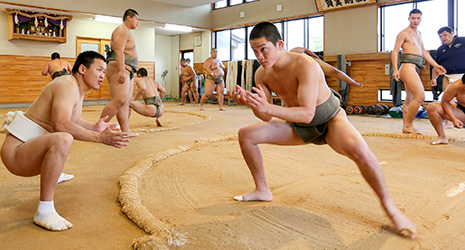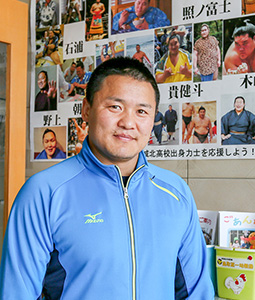Home > Highlighting JAPAN > Highlighting Japan July 2017 > My Way
Highlighting JAPAN


Teaching Japan’s National Sport
Renzendoruji Gantukus came to Japan from Mongolia to pursue a career as a sumo wrestler. Today he trains young enthusiasts of the sport — both Mongolian and Japanese.
Tottori Johoku High School in Tottori Prefecture is a prestigious high school for sumo wrestling. The advisor for the school’s sumo club is a Mongolian man named Renzendoruji Gantukus. Every year the high school accepts Mongolian students. Many of the students taught by Gantukus have successfully moved on to a professional career in the sport in Japan. In recognition of his achievements, the Mongolian president awarded Gantukus the Order of Altangadas (the Polar Star) this past May.
“The award ceremony was held at the Mongolian Embassy. Some of the wrestlers I had taught attended. I was also surprised and really glad to see Hakuho, my best friend and the 69th yokozuna,” says Gantukus.
Yokozuna is the highest rank in the hierarchy (banzuke) of professional sumo wrestlers. In recent years, Mongolians have dominated the sport of sumo. Starting with Asashoryu, who became the 68th yokozuna in 2003, four of the last five yokozuna have been Mongolian. (The 72nd wrestler to be promoted to the top rank, in January 2017, is Japanese.) Gantukus was among the Mongolians who came to Japan almost at the same time as Hakuho, dreaming of becoming a yokozuna.
Gantukus’ aspiration to become a sumo wrestler dates back to his childhood, when he won the third place at a Bökh (Mongolian wrestling) championship meet. The coach of the sumo club of Tottori Johoku High School had attended because Tottori Prefecture has a sister city relationship with Töv, Gantukus’ hometown. The coach discovered Gantukus’s talent and suggested that he come to Japan to train as a sumo wrestler. His mother was opposed to the suggestion. She loved Gantukus very much because he was the youngest of her six sons. However, his father and brothers supported the suggestion and Gantukus decided to go to Japan in March 2000. He was 15 years old.
Gantukus experienced difficulties such as the language barrier, new food and differences between Bökh and sumo. Despite these factors, he kept trying to improve and won fifth place in the singles tournament at the National Sports Festival in his second year of high school. As a third-year student, he was a regular at team competitions and won every major national meet.
Japanese sumo wrestling does not have weight restrictions. A small wrestler beating a larger one is one of the highlights of the sport. Since Gantukus was physically small, his favorite winning techniques were shitatenage (underarm throw) and shitatehineri (twisting underarm throw). These look very dynamic because they involve throwing a large opponent by getting under his upper body. However, it has a heavy physical burden. Gantukus suffered a bone displacement injury in his neck. He had to decide whether or not to undergo a serious operation. In the end, he gave up pursuing a professional career and moved on to amateur sumo wrestling, which has weight restrictions. Later, he received an offer from his alma mater for a job teaching young sumo wrestlers.
“The boys from Mongolia are all very weak at first. But as I teach them, they become stronger, as if they have become different men. This makes me feel the joy and wonder of teaching,” says Gantukus. “The boys from Mongolia are away from their home country and families. By learning many things, they become tougher mentally as well as in terms of their sumo skills. This also stimulates the Japanese boys and they positively influence each other.”
Gantukus is usually called “Gan Sensei” by his students (“sensei” is a term of respect meaning “teacher”). He is kind-hearted and endearing. In training, however, he is very stern. Japanese martial arts place an emphasis on respect. For example, it is said that judo begins and ends with respect. Sumo is particularly strict about its manners and behavior, partly because the sport originated from shrine rituals.
Gantukus says he had confronted the hard reality in the first days after he came to Japan. Now, he is highly regarded by those around him, including his students, as being more polite than an average Japanese person. The dohyo, the sumo wrestling ring, is a sacred place regardless of whether it is used for matches or practice. Of course Gantukus is strict with his technical guidance. Whenever he notices even a slight lack of respect in a student’s words or behavior during training, he mercilessly scolds the boy. This summer, the sumo club of Tottori Johoku High School is focused on winning the Inter High School Sports Festival for the second consecutive year. Gantukus’ teaching will become even more renowned.
His mother, who had been opposed to him leaving Mongolia, is now his biggest supporter. “When I think about my mother, sometimes I feel like returning to Mongolia, but I will stay in Japan. I think it is my mission to train future yokozuna,” says Gantukus. “My five-year-old son has also taken up sumo wrestling. Making him into a strong wrestler has been added to my list of dreams.”
Gan Sensei loves Japanese sumo wrestling more than anyone else. Perhaps he is trying to strengthen the sport itself.
© 2009 Cabinet Office, Government of Japan







